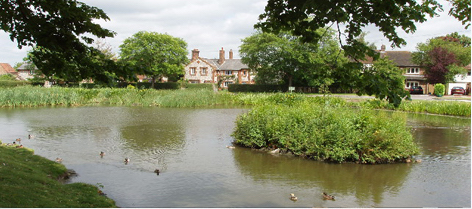
THERE’S a fresh feel to the village’s biggest community gathering this year, the Penn Seven and Super Fun Run, as it transforms into a sporting AND entertainment attraction on the common.
A reformed enthusiastic organising committee has injected some new ideas into the day, which started with a handful of charity runners in 1984 and has subsequently grown, raising tens of thousands of pounds for charity and involving many hundreds of participants over the years.
This year it’s moving from its traditional Father’s Day slot on a Sunday to a week earlier and on a Saturday, 10 June.
That means that once the races are concluded, the event can move into party mode with live music on stage until 10pm. Local singers and bands are lined up, including the popular singer Steph Wills and local band Black Sheep.

The seven mile circular Penn 7 run starts at 11am (preferably book online until 4 June but you can enter on the day) and the three and a half mile fun run to Hazlemere and back starts at 3pm. The mini-marathons for five, six and seven year olds start on the common from about 12.40. Everyone in every race gets a medal.
In addition, there’s a food village with a wide range of food and drink provided by professional local caterers; a well equipped bar and side shows and stalls for children. All profits are being donated to Penn and Tylers Green Village Care.
Everything you need to know, including how to enter and contacts if you would like to help with marshalling, stalls etc (as ever, they are short of volunteers) can be found on their stylish website, http://penn7.com
Homicide charges considered after Hammersley Lane crash
HOMICIDE charges are being considered by the Crown Prosecution Service (CPS) following a road crash that occurred at the bottom of Hammersley Lane, Tylers Green, over 18 months ago.

Moped rider Nesaar Khan, aged 20, of Wooburn Green, was on his way home after finishing his shift at Kentucky Fried Chicken in Wycombe Retail Park on 6 September, 2021.
He was killed following a collision with a Suzuki Jimny at the A40 junction with Hammersley Lane. The junction is controlled by traffic lights.
Police have spent over a year investigating the circumstances surrounding the crash and have now presented a file to the CPS for a decision on whether to bring criminal charges.
An opening inquest into the incident on 27 April heard that homicide charges were among those under consideration. The police have appointed a Family Liaison Officer to assist Nesaar’s family through the inquiry.
Buckinghamshire Coroner Crispin Giles Butler has adjourned the inquest until 18 July when a further hearing should discover whether charges are to be pressed.
Mary Berry’s former Penn home back on the market
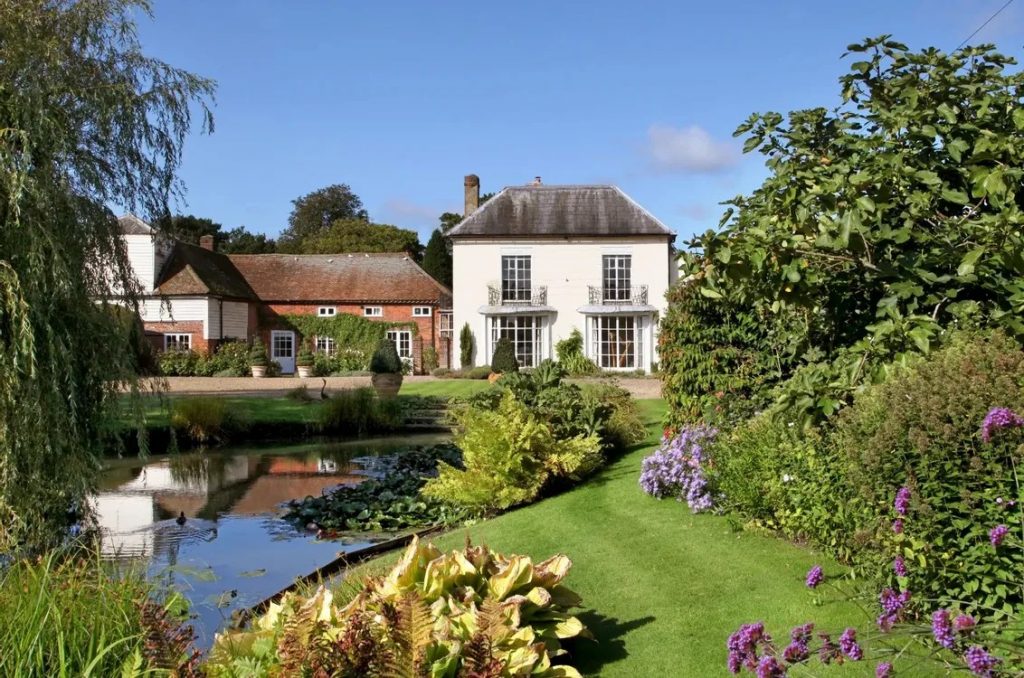
MARY Berry’s former Penn home, Watercroft, in Church Road, is back on the market just four years after it was sold.
TV cook Mary and her husband Paul Hunnings left the 200 year old home in 2018 to live in Henley.
However, they reportedly had to reduce the asking price from the original four million by several thousands of pounds to successfully complete the sale.
Now, the new owners, a Mr and Mrs A. Patten, are selling the six bedroom, Grade 2 listed house and its grounds, which includes a detached cottage and coach house, four years after moving in. The price is in the region of £3.75m.
Poet and adventurer takes the reins at Holy Trinity and St Margaret’s
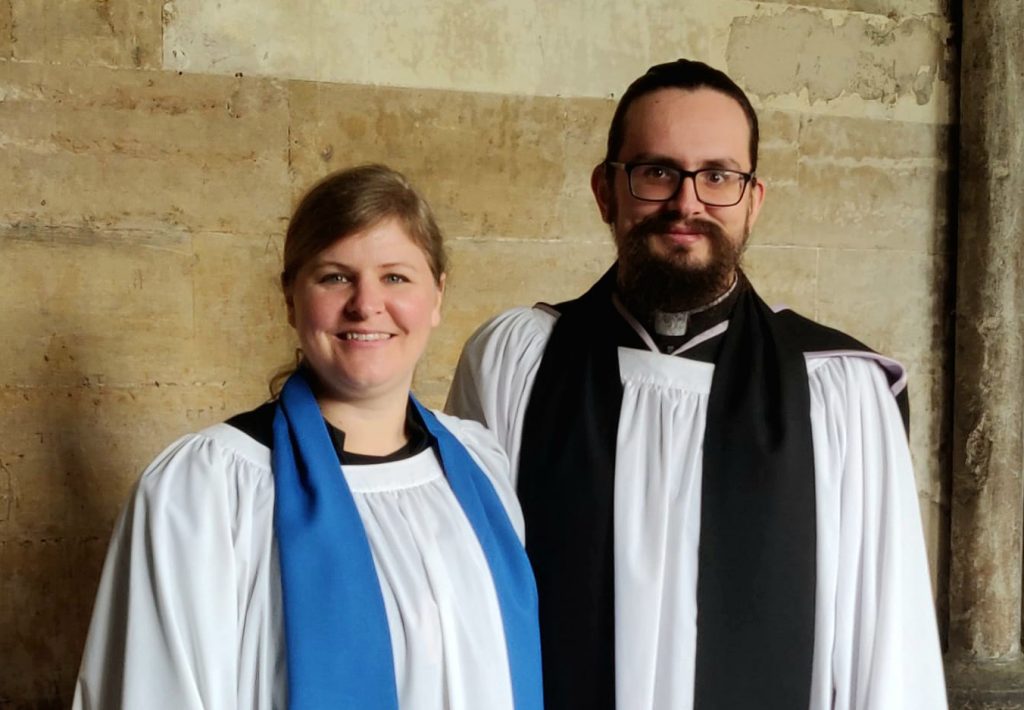
PENN and Tylers Green have a history of lively vicars and our new Church of England vicar is no exception.
At just 30 years old, the Rev Samuel Thorp is a published poet who has recorded nearly 100 of his sermons as podcasts; has a penchant for martial arts and ‘outdoor adventures’, and enjoys good books and good food.
This will be his first job in charge of a parish, having spent the last five years as a curate with the Diss team ministry in Norfolk.
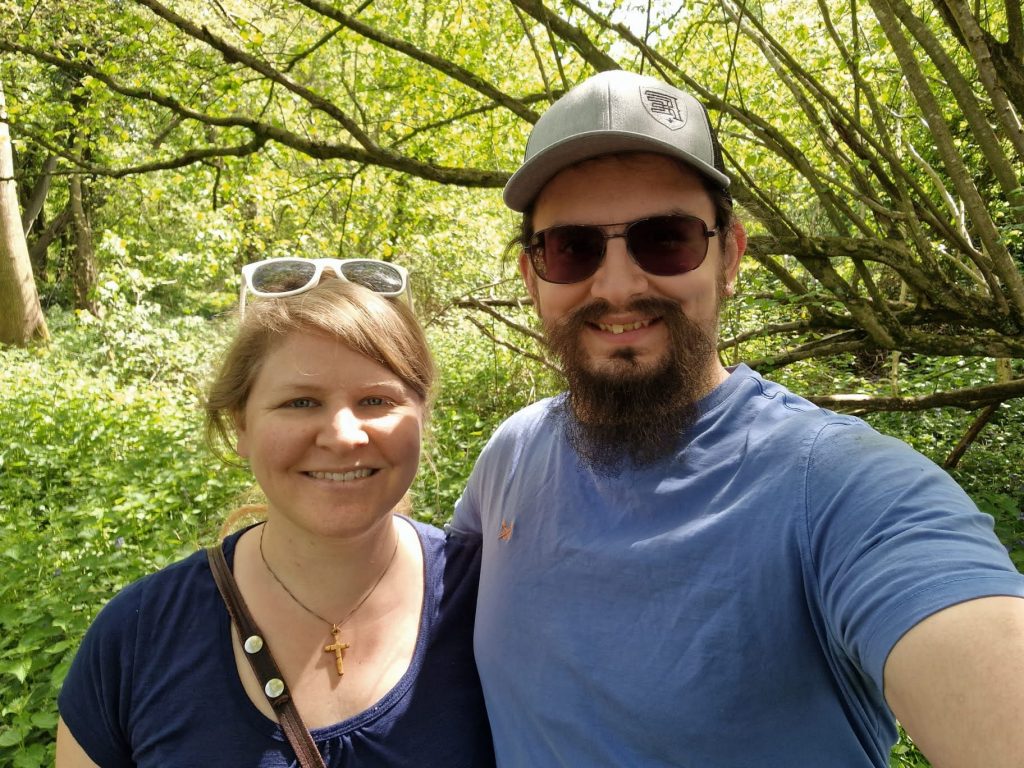
He grew up in Devon with his parents and a younger brother and sister. When he was 13 the family moved to Norfolk when his father Stephen became rector of Necton. His grandfather on his mother’s side was also a Church of England canon, and, although claiming that he would never grow up to be a vicar himself, Samuel’s “ love of ideas and arguments” led him to study theology, says his Linked-in profile.
He studied at the London School of Theology, graduating with a First Class BA (Hons) in Theology and also dating a Swedish student there, Linnea Arvedal, who later, in 2018, was to become his wife.
Linnea, a licensed lay minister, has a Scandinavian love of the countryside – “The right to roam and sleep under the stars should be universal,” she declares on her Twitter account.
His debut book of poems, published three years ago and entitled Glimpses, has received encouraging reviews while his personal website is packed with copies and podcasts of his previous sermons and thoughts.
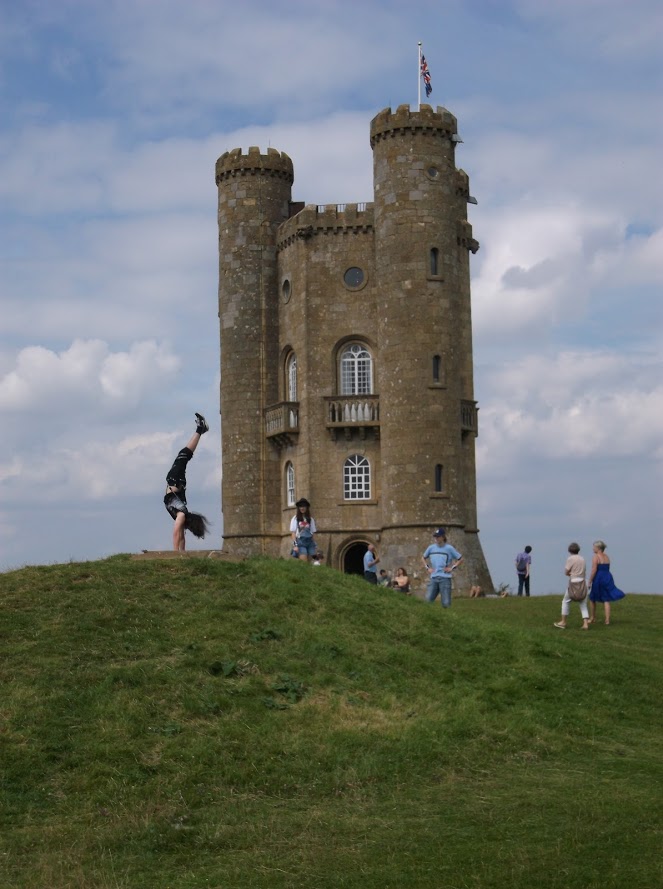
The couple, who will be living in the vicarage in Church Road, Penn, are expected to move in later this summer when the new vicar will take up his role. His licensing service has been set for 15 June. The Rev Thorp will be the 65th vicar of Holy Trinity and the 11th vicar of St Margaret’s.
(See Murder in the Vicarage at the end of this blog.)
First school asks for help as finances stretched

TYLERS Green First School has applied for a £2,000 grant from the local parish council after a tough year financially.
The grant, matched by a similar amount from the school’s parent/teacher association, will be for a new audio system and projector in the school hall.
Head teacher Mrs Jude Talbot told Chepping Wycombe Parish Council: “We have begun to include sign language as part of all our assemblies. This requires use of the overhead screen which is only two metres in size and can be quite difficult for the children…to see. We would like to purchase a larger screen as well as new projector and sound (system) to support the learning and singing we regularly do in assembly.”
She added: “In the past year we have spent considerable budget on increasing our staffing levels to support SEN (Special Educational Needs) children as well as supporting our children with reading and maths to help catch up post-lockdown.
“In addition, significant parts of our expenditure has been directed towards new fire safety measures and new security systems.”
The school caters for 177 pupils aged from four to seven. In recent months local charities and the PTA have provided new books for the school library and improved outdoor play equipment.
*The school is advertising for someone who speaks Russian to act as a part time teaching assistant from June to help children with Russian as their first language in the classroom and socially.
Ron’s charity marches gather pace…
THE CRICKETING world is really getting behind Tylers Green charity walker Ron Hedley.
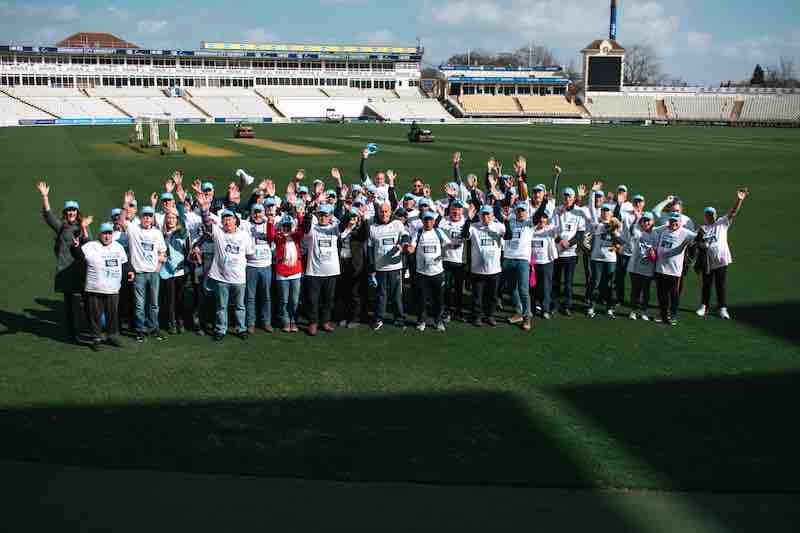
Ron, of Old Kiln Road, who is being treated for prostate cancer, has vowed to undertake 33 fund raising walks in conjunction with Prostate Cancer UK and the Bob Willis Fund.
He has been a life-long cricket player and fan and his walks have so far raised around £20,000. Last month walks starting from Warwickshire’s Edgbaston ground, Essex’s Chelmsford county ground and in Surrey helped further boost the fund.
His walks are being featured in Sky TV’s coverage of the Aussie test at Edgbaston next month.
He’s got a walk in Hertfordshire this month, followed next month by walks in Lincolnshire, Wales, Derbyshire and the Wormsley ground in Buckinghamshire. A quiz at Chesham Cricket Club in aid of prostate cancer research is being held on 12 May: contact Ron at rjhatters@yahoo.co.uk if you’d like to enter a team.
Don’t forget you can find out more and contribute on https://bobwillisfund.org/news/ronsmarch
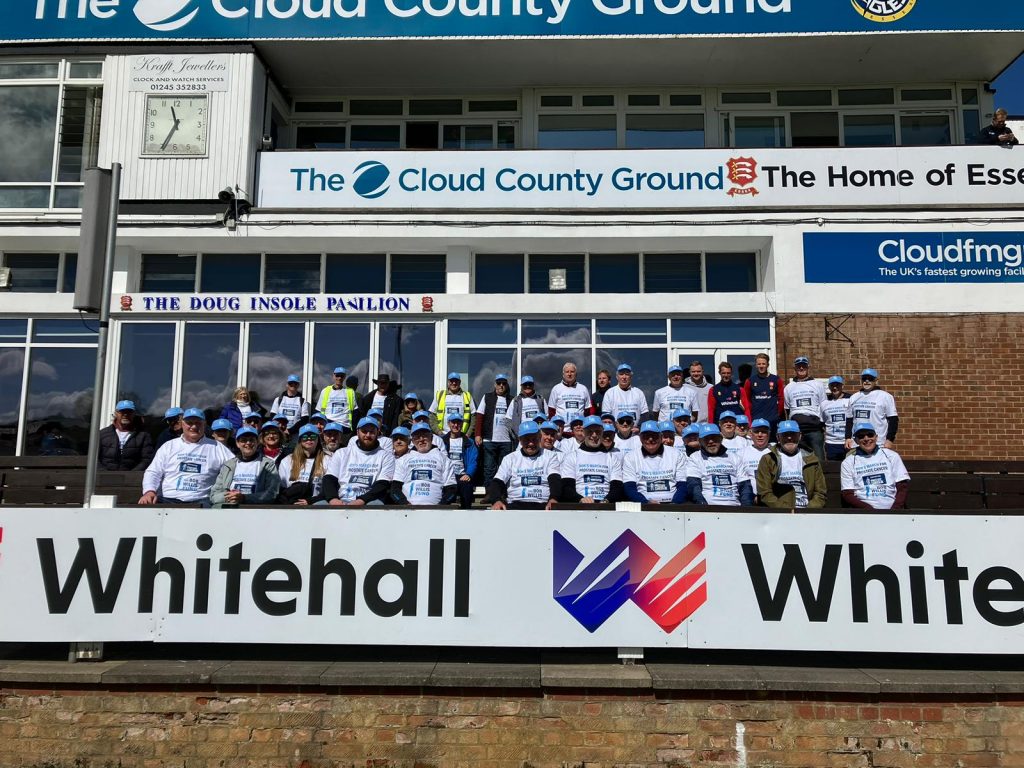
Local news

Coronation celebrations (updated) – This postbox in Church Road was given a Coronation makeover as the village celebrated King Charles III’s crowning.
Elsewhere there were a few street parties; Tylers Green First School children dressed in red, white and blue for a lunchtime picnic; and the village hall showed the Coronation live followed, in the afternoon, with a family film show. The hall was also the location for a tea-party and a talk on our “Royal connections”.
The Coronation was also shown live at Hazlemere Community Centre, followed by a street party and live music; while on 7 May it hosted a beer and gin festival.
Pupils music video – Tylers Green Middle School children have written and recorded a road safety song after the school won an award for its efforts to promote a safe travel-to-school plan. Bucks Radio were so taken by the song they produced a music video featuring the children which you can see on https://www.bucks.radio/news/local-news/tylers-green-pupils-create-street-smart-song/
Call for reform – Penn’s MP Sarah Green is calling for reform of family courts after telling the House of Commons that one of her constituents left an abusive relationship only to be “dragged back to the family court by their ex-partner 25 times…who was able to use the family court to further manipulate them and their child.” Justice minister Mike Freer said the Government was reviewing family law to “ensure people are protected from such abuse.”
Still “inadequate” – A snap inspection by Ofsted inspectors at Sir William Ramsay School found considerable improvements had been made by the new head teacher and his team since the “inadequate” rating for the school last year, particularly in safeguarding issues. However the inspectors and the head, Mr Paul Ramsey, say there is more to be done generally so the rating remains “inadequate”.
Charity timber stolen – Parish council accounts show that Chepping Wycombe earned £4,299 from selling timber from King’s Wood, Tylers Green, in the year to the end of March. Meanwhile police have been called in following a significant theft of felled timber from Penn’s Common Wood. The wood is owned by the Penn and Tylers Green Residents’ Society and managed by the Woodland Trust, both registered charities, and the sale of wood is an important source of income.
Barnaby’s back – Film-makers were back using the old part of Elm Road, including the Red Lion, in Penn as well as street and house locations in Tylers Green last month filming scenes for the next series of ITV’s Midsommer Murders.
Roller disco – Hazlemere Youth Centre in Rose Avenue has started monthly roller disco sessions.
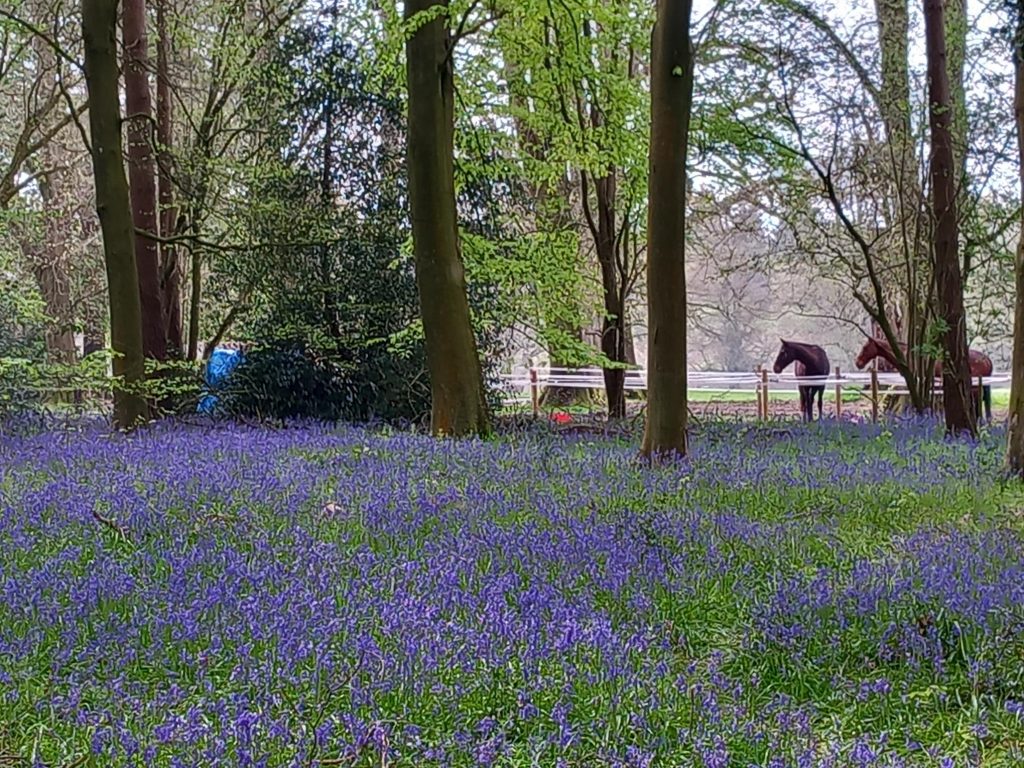
The cold winter and early spring meant the bluebell displays in Chilterns woodlands were a week or two behind schedule this year. But as everyone, including these horses at Penn Street, testified, it was well worth the wait.
Coronations past: carnival queens, fireworks, processions and an egg and spoon race
IT’S FAIR to say our Coronation celebrations this time round have been rather more modest than previous Coronations, but there again times have changed.

1902
The Coronation of King Edward VII, Queen Victoria’s son, was due to be held in June but the king was taken ill with appendicitis and had an emergency operation – a risky business in those days – so the celebrations were put on hold until 9 August.
Penn and Tylers Green were somewhat separate communities at the very beginning of the 20th century but for the Coronation the two populations celebrated together. The congregations of Holy Trinity and St Margaret’s joined for a service which included a rendition of Handl’s Hallelujah Chorus – sung heartily, according to the Bucks Free Press – with the vicar singing the first verse solo.
Then, Sir Philip Rose, who lived at Rayners and who loved any excuse to put on a firework display, invited villagers round to enjoy what the local paper described as “bombs in the sky”. At both events collections were taken for the “sick and needy of the parish.”
1911
George V’s Coronation on 22 June was a truly spectacular affair in Penn and Tylers Green.
An 8am Holy Communion at Holy Trinity, Penn was so packed there was no standing room left inside “while 100 late-comers had to remain in porches or stand outside in the churchyard.”
It concluded with the National Anthem with a local paper reporting… “never before had such a grand volume of sound rolled through the arches and aisles of the old Norman church.”
At Tylers Green there was also a heavily attended 8am Holy Communion before everyone gathered outside St Margaret’s to see the new St George’s flag, especially bought for the occasion, unfurled.
Then it was onto the common for sports and games, a daytime fireworks display by Sir Philip, live music from the Lane End Orpheus Band followed by “a huge pile of bread and butter and cake – enough for 450 – and many gallons of tea put away by youngsters”.
Every child was presented with Coronation medals, buns and flags and the evening was spent “dancing on the green”.
Meanwhile in Penn, the local populace went to the adjoining Knoll meadow after the church service to enjoy games, sports and singing and watch children dancing round the Maypole.
Then it was over to the old Penn schoolroom where “150 sat down to a bountiful repast and knife and fork spread” followed by the judging of the decorated cottages competition.
At 8.30pm followed an event that must have lived long in the memories of those who witnessed it. One hundred men, four abreast, and each carrying a flaming torch “followed by several hundred men, women and children” singing patriotic songs marched up Beacon Hill. All that culminated in a grand bonfire.
It wasn’t the only bonfire in the district. Those who clambered to the top of Holy Trinity tower as it was getting dark counted 43 visible bonfires.
That wasn’t the end of celebrations in Penn and Tylers Green however.
Sir Philip invited everyone from both villages to witness his most spectacular firework display yet and there were gasps of awe from people as they entered the gardens at Rayners where he and his staff had adorned the trees with more than 2,000 fairy lights.
It was well after midnight before everyone made their weary way home after contributing to a collection for parish relief.
1937
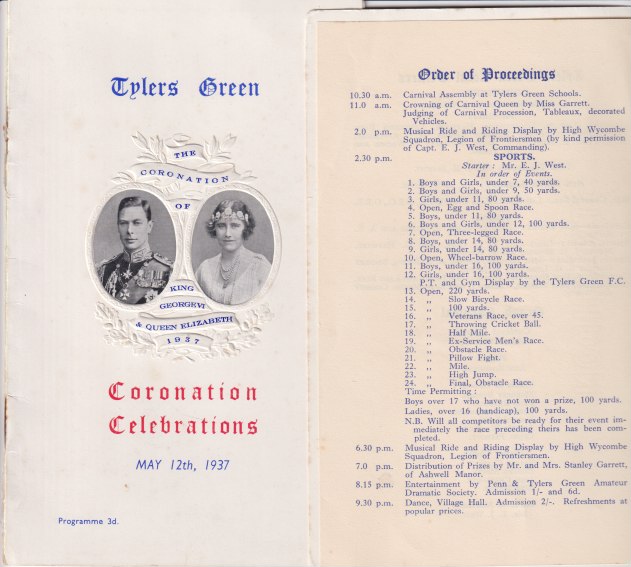
Loudspeakers connected to the wireless were placed on the common so people could listen to the Coronation ceremony in the morning and the new King George’s VI’s speech in the evening.
In between there was a carnival procession with carnival queen, sports and riding displays on the common, including an egg and spoon race and a pillow-fight, a variety show performed by the Penn and Tylers Green Amateur Dramatic Society and a dance in the recently opened village hall.
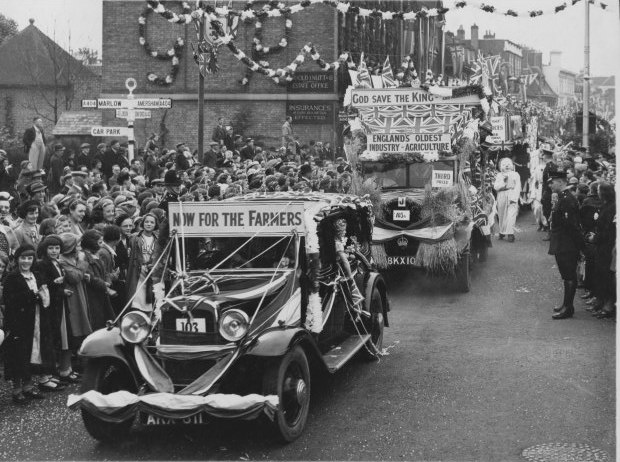
1953
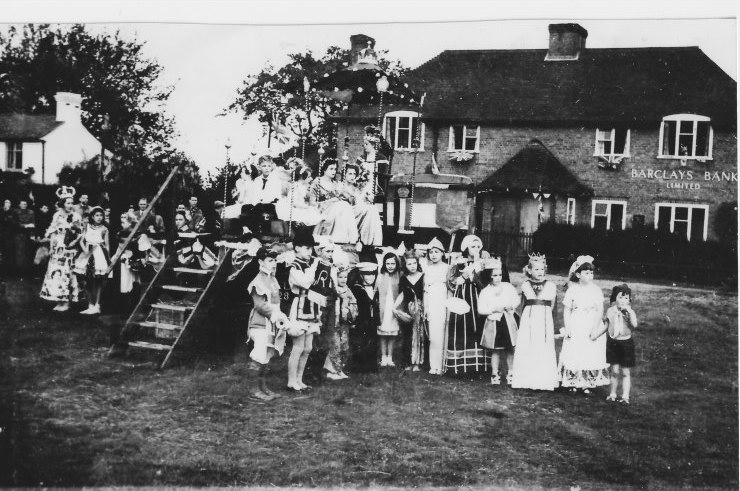
There was a carnival queen too for Queen Elizabeth’s Coronation in 1953 but a planned parade around the village had to be abandoned because the weather was so awful.
Instead it was confined to the common and some of the planned fun and games transferred intoTylers Green School. All the children received Coronation mugs while the village hall dance didn’t conclude until the early hours.
In a sign of times to come a local paper reported there was “a hush” over Penn village until mid-afternoon “while people watched the Coronation procession and ceremony on television sets.”
New chapters for three former local lads…
THESE are exciting times for three of Holmer Green Senior School’s most famous ex-pupils.

First, actor Aaron Taylor-Johnson, aged 32, who was simply stage-struck pupil Aaron Johnson when he was there between 2001 and 2006, is now the bookie’s joint-favourite to be the next James Bond after Daniel Craig’s departure.
His chances won’t have suffered when an artificial intelligence (AI) company was asked to come up with an ideal-looking James Bond. The end product looked remarkably like the real-life Aaron.

Second, actor and entertainer James Corden, 44, is preparing to return “home” with his family this month after completing eight hugely successful years in America.
He hosted his last Late, Late Show on US TV on 27 April. What happens next in his mega-career is eagerly awaited. Builders are completing a rebuild of his mansion on a 43 acre estate overlooking the Thames near Henley – but he will undoubtedly be visiting his parents who, like Aaron’s parents, still live in the Hazlemere area.
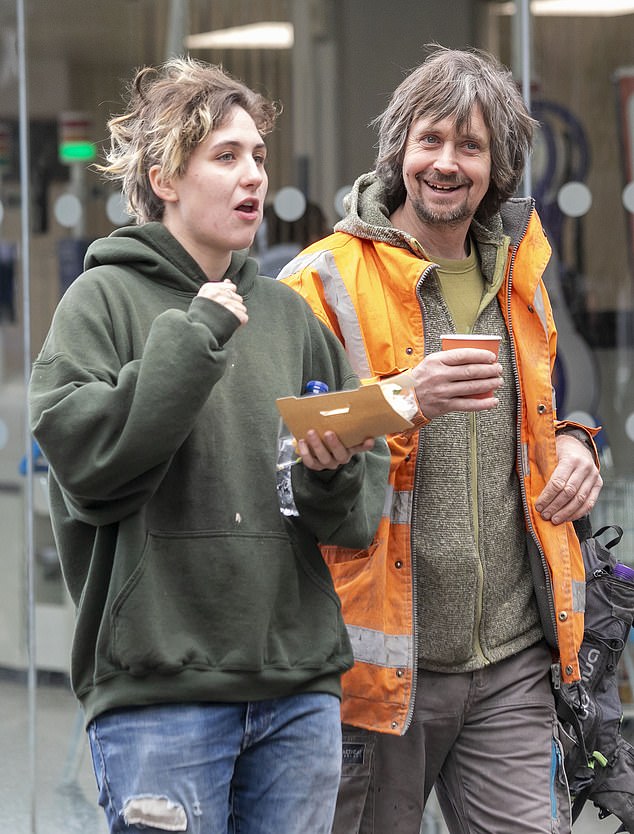
And third, Britain’s most famous environmental activist, Daniel Hooper, 50, universally known as Swampy, should find out this month the date for a retrial on charges of aggravated trespass following the collapse of an earlier case.
Swampy and other protestors camped for a month in construction tunnels in Euston Square Gardens last year in protest at the redevelopment of the area caused by the HS2 high speed railway.
Dear Dom, here’s Howe to do it…

TALKING of school old boys, the Dr Challoner’s grammar school pupil who rose to be deputy prime minister – one Dominic Raab – found that the old school tie didn’t help much in his hour of need last month when, much to his disgust, he had to resign from the cabinet for being jolly beastly to civil servants.

Another ex-pupil at the Amersham grammar school is MP Greg Hands who, as the current chairman of the Conservative Party, is pretty influential. But from Mr Hands not a word of support, publicly at any rate.

No word either from another famous ex-pupil, but less surprisingly perhaps. Eddie Howe, the manager of Newcastle United, has made his way in the much rougher but better-paid world of premiership football.
He’s particularly good at achieving success for his team with a passion that’s tempered by a notable calmness under pressure…perhaps he could pass on a few tips to his old school mucker!
Has Michael Gove put the cat amongst the Gomm Valley pigeons?
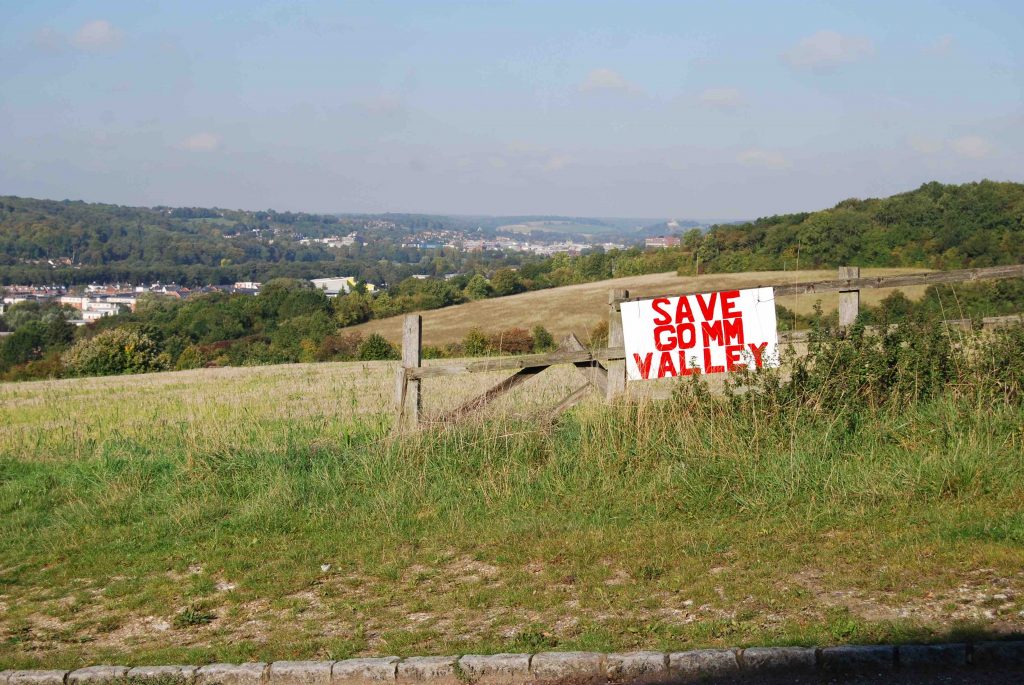
A SURPRISE Government decision to reject a housing development because the housing design proposed wasn’t good enough will set the cat amongst the pigeons in the Gomm Valley, between Cock Lane and Hammersley Lane, Tylers Green.
Mass house builder Berkeley Homes had won its planning battle with local residents and conservation groups to build 165 homes in Crane Valley, an area of outstanding natural beauty (AONB) near Tunbridge Wells in Kent. Following a public inquiry a Government planning inspector said the scheme could go ahead.
But then last month the Housing Secretary Michael Gove stepped in and over-ruled the planning inspector.
A Government spokesman said: “Although Mr Gove agrees with the inspector that the proposed development would deliver landscape enhancements, he does not find the proposal to be of a high standard. Overall, he does not find the scheme is sensitively designed having regard to its setting.”
This unique intervention will give much food for thought at Taylor Wimpey, the mass house-builder planning to build up to 600 homes and other facilities in the Gomm Valley.

Although detailed plans have yet to be submitted, critics have been quick to point out that illustrations produced in Taylor Wimpey’s Gomm Valley publicity material show the same sort of designs to be found in the company’s urban and suburban developments in other parts of the country.
Yet the Gomm Valley is an environmentally sensitive area, containing a nature reserve and a Site of Special Scientific Importance (SSSI).
It abuts the Chilterns AONB and may well become part of it when Natural England produces its recommendations for expanding the Chilterns AONB.
In addition, the political climate is hardening with local authorities, including Buckinghamshire, dropping the housing targets they were forced to set which meant the release of the Gomm Valley site for housing in the first place.
Bucks is doing so with Government approval following, among other things, the dramatic loss by the Conservatives at the Chesham and Amersham by-election in 2021. An analysis of the by-election result showed many people voted against the Tories because of the constant demand to build houses in green-field sites.
Mr Gove made his intentions clear late last year when he told builders he would crack down on “ugly identikit” houses “plonked down without regard to the shape and character of existing communities”. Now he has taken action to back that up.
In the Gomm Valley, it will be interesting to see Taylor Wimpey’s response.
UPDATED: Berkeley Homes announced early May they are taking Mr Gove to court to challenge his decision.
Regional news
Burglaries soar – Reported burglaries more than doubled in the first three months of this year compared to last. The neighbourhood policing team for Amersham, the Chalfonts and the Missendens, which includes Penn, said 50 houses were reported burgled this year compared to 19 in the first three months of last year. This doesn’t include break-ins to garages and sheds.
Rising gymnast – Aylesbury gymnast Jessica Gadirova, 18, who won BBC Young Sports Personality of the Year last year, won three gold medals at the European Gymnastics in Turkey last month.
Back to front – Amersham project manager Tom Harrison, 46, came last of the 48,000 finishers at London Marathon, but that’s because he walked the 26.2 miles backwards. It took him 12 hours and 45 minutes, raising money for the Red Cross.
Museum saved – The future of the Chilterns Open Air Museum in Chalfont St Peter now looks secure after the museum bought the freehold of the land it occupies for £1. The former land owners, Comer Homes, had blocked off the area the museum uses for parking in a row over the lease. The settlement came about after the intervention of the Government, the Arts Council, Bucks Council and local MP Sarah Green.
RAF flypast – The RAF will be staging a flypast over RAF Halton on 24 May to mark the completion of training for new recruits. On 25 June RAF personnel from the base will be marching through Wendover to commemorate their Freedom of the town. The base will begin running down next year in preparation for its closure in 2025 when it will be converted to housing.
Refugees settle – The council reported that just over 1500 Ukrainians are living in Buckinghamshire, having fled their country following the Russian invasion.
Golf club sold – The John Lewis Partnership completed the sale of its Winter Hill Golf Club in Cookham to Safegolf Ltd, who in turn will give a long lease to the charity Get Golfing.
Top attraction – The Queen’s platinum jubilee and later her death meant that Windsor Great Park became Britain’s number one tourist attraction last year with 5.6million visitors, according to official sources.
More scouting memories…
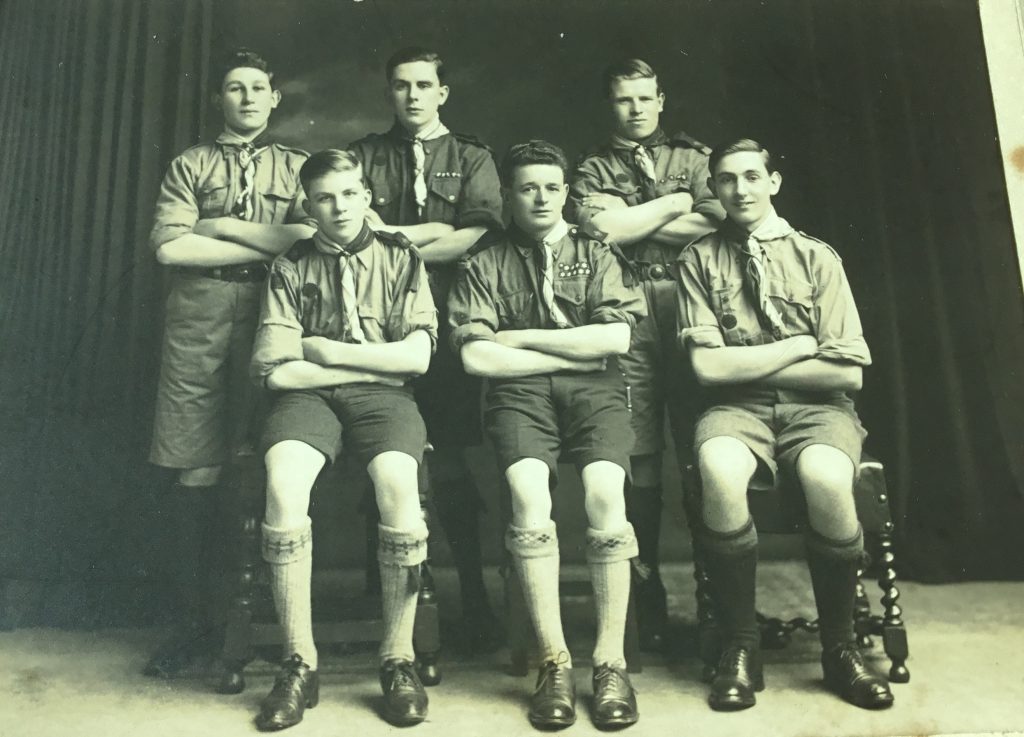
PENN and Tylers Green scouts continue to prepare for their celebrations to mark 100 years since the official formation of the village scout troop, with a get-together on the back common on 17 June (see last blog).
The item prompted Pamela White (nee Rolfe) to send a copy of the photo above which shows her dad, Bill Rolfe, seated in the centre of the front row together with Jack Chivers on the left and Sid Nichols on the right. The back row, left to right, is Keith Barnes, Tom Perrin and Harry Pusey. They were all Tylers Green Rover scouts in the 1930s.
Pamela writes: “I can recall when I was quite young going to see the scouts in their tents at Ashwells. It must have been in the 1930s/early 1940s as my dad was scout master and he went into the army in the very early 1940s. Dad was head gardener at Ashwells when it was owned by Mr Garrett and then taken over by Bucks County Council as a home for the blind. I was in the village guides for years with the two Miss Beatties.“
Incidentally, while Tina and I were researching the Coronation archive mentioned above, we discovered that the scouts played quite a big role in helping organise the 1911 celebrations in the village, with Mr Long, the school headmaster, and Mr E.N. Bartlett as scout master. This indicates scouts were active here just three years after Robert Baden-Powell formed the movement. We can only assume that the budding scouts group in Tylers Green was subsequently snuffed out at the start of the First World War and then officially formed in 1923, hence this year’s centenary celebrations.
Murder in the Vicarage. It was the servant with the axe in the study.
HOPEFULLY, this will in no way deter our new vicar, but it just so happens that next month marks the 655th anniversary of the rather gruesome murder of the vicar of Penn in his own vicarage.
In 1368 the unfortunate William de Clifton had his head split open three times by an axe, apparently wielded by his servant John.
Within two days the county coroner had gathered 12 jurors who decided that John was the culprit. Further “he feloniously stole one horse the value of 30 shillings, and 18 silver spoons valued at 18 shillings” plus “money, linen and woollen garments and other chattels to the value of £10.”
There’s no record, however, of whether John was ever caught.
Info from J.G. Jenkins’ book History of Penn, republished in part on the church’s heritage website by Miles Green.
You can contact this blog at peter@pennandtylersgreen.com It is next due to be fully updated on 1 June.
